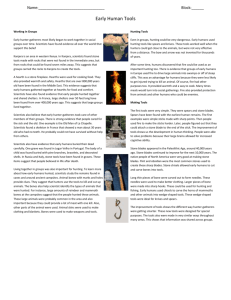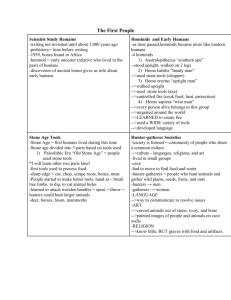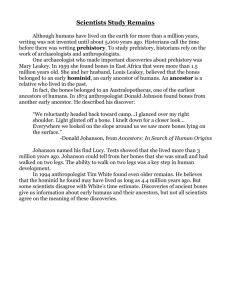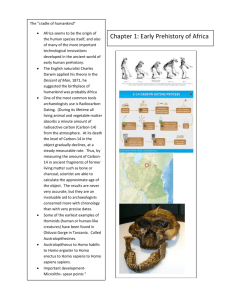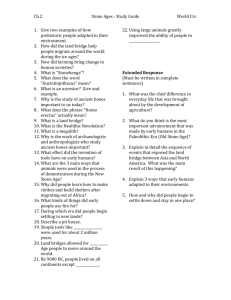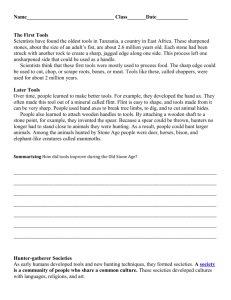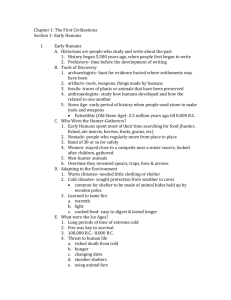Evolution of Cultural Behavior
advertisement
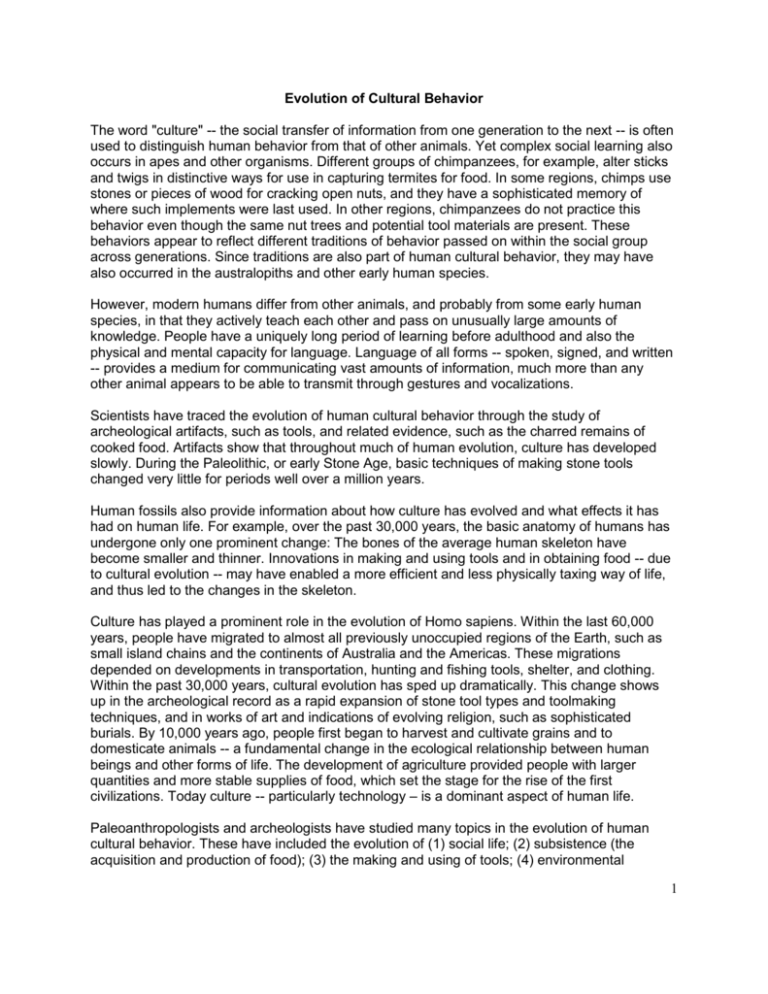
Evolution of Cultural Behavior The word "culture" -- the social transfer of information from one generation to the next -- is often used to distinguish human behavior from that of other animals. Yet complex social learning also occurs in apes and other organisms. Different groups of chimpanzees, for example, alter sticks and twigs in distinctive ways for use in capturing termites for food. In some regions, chimps use stones or pieces of wood for cracking open nuts, and they have a sophisticated memory of where such implements were last used. In other regions, chimpanzees do not practice this behavior even though the same nut trees and potential tool materials are present. These behaviors appear to reflect different traditions of behavior passed on within the social group across generations. Since traditions are also part of human cultural behavior, they may have also occurred in the australopiths and other early human species. However, modern humans differ from other animals, and probably from some early human species, in that they actively teach each other and pass on unusually large amounts of knowledge. People have a uniquely long period of learning before adulthood and also the physical and mental capacity for language. Language of all forms -- spoken, signed, and written -- provides a medium for communicating vast amounts of information, much more than any other animal appears to be able to transmit through gestures and vocalizations. Scientists have traced the evolution of human cultural behavior through the study of archeological artifacts, such as tools, and related evidence, such as the charred remains of cooked food. Artifacts show that throughout much of human evolution, culture has developed slowly. During the Paleolithic, or early Stone Age, basic techniques of making stone tools changed very little for periods well over a million years. Human fossils also provide information about how culture has evolved and what effects it has had on human life. For example, over the past 30,000 years, the basic anatomy of humans has undergone only one prominent change: The bones of the average human skeleton have become smaller and thinner. Innovations in making and using tools and in obtaining food -- due to cultural evolution -- may have enabled a more efficient and less physically taxing way of life, and thus led to the changes in the skeleton. Culture has played a prominent role in the evolution of Homo sapiens. Within the last 60,000 years, people have migrated to almost all previously unoccupied regions of the Earth, such as small island chains and the continents of Australia and the Americas. These migrations depended on developments in transportation, hunting and fishing tools, shelter, and clothing. Within the past 30,000 years, cultural evolution has sped up dramatically. This change shows up in the archeological record as a rapid expansion of stone tool types and toolmaking techniques, and in works of art and indications of evolving religion, such as sophisticated burials. By 10,000 years ago, people first began to harvest and cultivate grains and to domesticate animals -- a fundamental change in the ecological relationship between human beings and other forms of life. The development of agriculture provided people with larger quantities and more stable supplies of food, which set the stage for the rise of the first civilizations. Today culture -- particularly technology – is a dominant aspect of human life. Paleoanthropologists and archeologists have studied many topics in the evolution of human cultural behavior. These have included the evolution of (1) social life; (2) subsistence (the acquisition and production of food); (3) the making and using of tools; (4) environmental 1 adaptation; (5) symbolic thought and its expression through language, art, and religion; and (6) the development of agriculture and the rise of civilizations. Social Life Most primate species, including the African apes, live in social groups of varying size and complexity. Within their groups, individuals often have multifaceted roles, based on age, sex, status, social skills, and personality. The discovery in 1975 at Hadar, Ethiopia, of a group of several Australopithecus afarensis individuals who died together 3.2 million years ago appears to confirm that early humans lived in social groups. Scientists have referred to this collection of fossils as The First Family. One of the first physical changes in the evolution of humans from apes -- a decrease in the size of male canine teeth -- also indicates a change in social relations. Male apes sometimes use their large canines to threaten (or sometimes fight with) other males of their species, usually over access to females, territory, or food. The evolution of small canines in australopiths implies that males had either developed other methods of threatening each other or become more cooperative. In addition, both male and female australopiths had small canines, indicating a reduction of sexual dimorphism from that in apes. Although sexual dimorphism in canine size decreased in australopiths, males were still much larger than females. Thus, male australopiths might have competed aggressively with each other based on sheer size and strength, and the social life of humans may not have differed much from that of apes until later times. Scientists believe that several of the most important changes from apelike to characteristically human social life occurred in species of the genus Homo, whose members show even less sexual dimorphism. These changes, which may have occurred at different times, included (1) prolonged maturation of infants, including an extended period during which they required intensive care from their parents; (2) special bonds of sharing and exclusive mating between particular males and females, called pair-bonding; and (3) the focus of social activity at a home base, a safe refuge in a special location known to family or group members. Parental Care Humans, who have a large brain, have a prolonged period of infant development and childhood because the brain takes a long time to mature. Since the australopith brain was not much larger than that of a chimp, some scientists think that the earliest humans had a more apelike rate of growth, which is more rapid than that of modern humans. This view is supported by studies of australopith fossils that have examined tooth development, which is thought to be a good indicator of overall body development. In addition, the human brain becomes very large as it develops, so a woman must give birth to a baby at an early stage of development in order for the infant's head to fit through her birth canal. Thus, human babies require a long period of care to reach a stage of development at which they depend less on their parents. In contrast with a modern female, a female australopith could give birth to a baby at an advanced stage of development because its brain would not be too large to pass though the birth canal. The need to give birth early -- and therefore to provide more infant care -- may have evolved around the time of the species Homo ergaster. This species had a brain significantly larger than that of the australopiths, but a narrow birth canal. 2 Pair-Bonding Pair-bonding, usually of a fairly short duration, occurs in a variety of primate species. Some scientists speculate that prolonged bonds developed in humans along with increased sharing of food. Among primates, humans have a distinct type of food-sharing behavior. People will delay eating food until they have returned with it to the location of other members of their social group. This type of food sharing may have arisen at the same time as the need for intensive infant care, probably by the time of H. ergaster. By devoting himself to a particular female and sharing food with her, a male could increase the chances of survival for his own offspring. The Home Base Foraging peoples, or hunter-gatherers, obtain food when and where it is available in the territory surrounding a central campsite, or home base. In modern foraging societies, such as that of the San people in the Kalahari Desert of southern Africa, men and women divide work duties. Women gather readily available plant and animal foods, while men take on the often less successful task of hunting. Female and male family members and relatives bring together their food to share at their home base. Sharing of food at the home base is usually done within the family, including relatives. Because some of the oldest archeological sites were places where food remains and stone tools were found together, they were thought to represent home bases, indicating many of the social features of modern hunter-gatherer campsites, including pair-bonded males and females. Indeed, with further study, marks on bones were detected proving that early humans cut up and bashed open animal bones at these sites. Yet tooth marks made by hyenas, cats, and jackals were also prevalent, indicating that potential predators were active at these sites. Safe home bases where social groups lived, children were active, the sick were attended, and food was brought for sharing, may have developed sometime after 1.7 million years ago. In fact, evidence of hearths and shelters, typical of modern human home bases, are not clearly evident in the archeological record until after 500,000 years ago. Subsistence Human subsistence refers to the types of food humans eat, the technology used in and methods of obtaining or producing food, and the ways in which social groups or societies organize themselves for getting, making, and distributing food. For millions of years, humans probably fed on-the-go, not unlike other primates. The great apes eat mostly plant foods. Many primates also eat easily obtained animal foods such as insects and bird eggs. Among the few primates that hunt, chimpanzees will prey on monkeys and even small gazelles. The first humans also had a diet based mostly on plant foods. In addition, they undoubtedly ate some animal foods and might have done some hunting. Human subsistence began to diverge from that of other primates with the production and use of the first stone tools. With this development, the meat and marrow (the inner, fat-rich tissue of bones) of large animals became a part of the human diet. Scientists have found broken and butchered fossil bones of antelopes, zebras, and other comparably sized animals at the oldest archeological sites, which date from about 2.5 million years ago. At younger sites, about 1.8 million years old, scientists have discovered that many bones have been cut and broken by the toolmakers. With the evolution of late Homo, humans began to hunt even the largest animals on Earth, including mastodons and mammoths, members of the elephant family. Agriculture and the domestication of animals arose only in the recent past, with H. sapiens. 3 Views/Interpretations/Models of Subsistence in Homo The idea that predation and meat-eating had a strong effect on early human evolution is known as the hunting hypothesis. According to this hypothesis, acquiring meat by aggressive hunting with primitive tools was the main way that the oldest human ancestors survived in the arid environments in Africa. Hunting and competition with the meat-loving carnivores, it was thought, had great impact on human social behavior, toolmaking, and the evolution of intelligence. Many advocates of the hunting hypothesis believe that toolmaking had a big influence on the evolution of human hands, brains, and social groups. Tools and hunting thus acted as powerful forces in early human evolution. Since the 1960s, the hunting hypothesis has been called into doubt. For one thing, scientists discovered that chimpanzees hunt at least small animals, and so the evolution of the capacity to hunt itself did not set the earliest humans apart as much as we once thought. Some scientists instead argued in favor of the importance of food sharing in early human life. According to a food-sharing hypothesis, cooperation and sharing within family groups -- instead of aggressive hunting -- strongly influenced the path of human evolution. Although the food-sharing idea was also criticized, it led to a more careful study of animal bones from the early archeological sites. From this research, scientists began to think that scavenging meat and bone marrow from dead animals was more important than hunting. The scavenged body parts were carried away to special places for further cutting and bashing with stone tools; these places were the tool-andbone sites dug up by archeologists. The scavenging idea was supported when scientists observed that antelopes and other animals often die in the dry season. So maybe early toolmakers also had an opportunity to scavenge animal fat and meat during dry times of the year. Other archeological studies -- and the occasional hunting by chimpanzees -- suggest, however, that the scavenging hypothesis is too narrow. A broader view is that early humans did a combination of scavenging and hunting. Although new evidence can change things, most paleoanthropologists agree that early human toolmakers scavenged at least the larger animals (and also ate plant foods). There is still a difference of opinion about how much hunting was done, especially of smaller animals. The Rise of Hunting Scientists still debate about when humans first began hunting on a regular basis. For instance, elephant fossils found with tools made by middle Homo once led researchers to the idea that these early humans were hunters of big game. However, the simple association of animal bones and tools at the same site does not necessarily mean that early humans had killed the animals or eaten their meat. Animals may die in many ways, and natural forces can accidentally place fossils next to tools. Recent excavations at Olorgesailie, Kenya, show that H. erectus cut meat from elephant carcasses but do not reveal whether these humans were hunters. Humans who lived outside of Africa -- especially in colder temperate climates -- almost certainly needed to eat more meat than their African counterparts. Humans in temperate Eurasia would have had to learn about which plants they could safely eat, and the number of available plant foods would have dropped significantly during the winter. Although scientists have found very few fossils of edible or eaten vegetation at sites, nevertheless the early inhabitants of Europe and Asia probably did eat plant foods in addition to meat. Sites that provide the clearest evidence of early hunting include Boxgrove, England, where about 500,000 years ago people trapped a great number of large game animals between a 4 watering hole and the side of a cliff and then slaughtered them. At Sch`ningen, Germany, a site about 400,000 years old, scientists have found wooden spears with sharp ends that were well designed for throwing and probably used in hunting large animals. Neanderthals and other archaic humans seem to have eaten whatever animals were available at a particular time and place. So, for example, in European Neanderthal sites, the number of bones of reindeer (a cold-weather animal) and red deer (a warm-weather animal) fluctuated depending on the ancient climate. Like earlier humans, Neanderthals probably combined hunting and scavenging to obtain animal protein and fat. For at least the past 100,000 years, various human groups have eaten foods from the ocean or coast, such as shellfish, and some sea mammals and birds. Others began fishing in interior rivers and lakes. Between probably 60,000 and 90,000 years ago, people at the site of Katanda, Democratic Republic of Congo, caught large catfish using a set of barbed bone points, the oldest known specialized fishing implements. The oldest stone tips for arrows or spears date from about 40,000 to 50,000 years ago. These technological advances, probably first developed by early modern humans, indicate an expansion in the kinds of food humans could obtain. Beginning 40,000 years ago humans began making even more significant advances in hunting dangerous animals and large herds, and in exploiting ocean resources. People cooperated in large hunting expeditions in which they killed great numbers of reindeer, bison, horses, and other animals of the expansive grasslands that existed at that time. In some regions, people became specialists in hunting certain kinds of animals. The familiarity these people had with the animals they hunted is manifested in sketches and paintings on cave walls, dating from as much as 32,000 years ago. Hunters also used the bones, ivory, and antlers of their prey to create art and beautiful tools. Later on, in some areas, such as the central plains of North America that once teemed with a now-extinct type of large bison, hunting may have contributed to the extinction of entire species. Tools The making and use of tools alone probably did not distinguish early humans from their ape predecessors. Instead, humans made the important breakthrough of using one tool to make another. Specifically, they developed the technique of precisely hitting one stone against another, known as knapping. Stone toolmaking characterized the period sometimes referred to as the Stone Age, which began at least 2.5 million years ago in Africa and lasted until the development of metal tools within the last 10,000 years (at different times in different parts of the world). Although early humans may have made stone tools before 2.5 million years ago, toolmakers may not have returned often enough to one spot to leave clusters of tools that can be easily detected. The earliest simple form of stone toolmaking involved breaking and shaping an angular rock by hitting it with a palm-sized round rock known as a hammerstone. Scientists refer to tools made in this way as Oldowan, after Olduvai Gorge in Tanzania, a site from which many such tools have come. The Oldowan tradition lasted for about 1 million years. Oldowan tools consist of larger stones with a sharp chopping edge, and small flakes that could be used to scrape and slice. Sometimes Oldowan toolmakers used anvil stones, flatter rocks sitting or placed on the ground, on which hard fruits or nuts could be broken open. Chimpanzees today, in fact, are known to use anvils for cracking nuts. 5 Because of the different shapes and flake scars on Oldowan stones, scientists once believed that the toolmaker (possibly Homo habilis) intentionally made different "tool types" (called chopper, scraper, and so on). If so, Homo habilis must have had a culture and language in order to teach how to make the different kinds of tools. But this idea led scientists to make new observations, which showed that the different tool types were not really distinct from one another. Instead, the original rocks had different shapes (like a rounded pebble or flattened slab), and these were then struck a different number of times by the toolmakers, without trying to create any particular shape. It's now thought that making sharp-edged rocks was the main goal of early stone flaking. Learning this skill certainly required observation but not necessarily instruction or language. Oldowan toolmakers sought out the best stones for making tools and carried them over long distances to new locations. In at least some situations, the toolmakers also gained access to large animals and carried portions of the carcasses to these same locations, thus avoiding any predators that might return to a kill. At these toolmaking and food-processing sites, the toolmakers would further butcher carcasses and eat the meat and marrow. This behavior of bringing food and tools together contrasts with an eat-as-you-go strategy of feeding commonly seen in other primates. (Actually, some chimpanzees and orangutans have been observed carrying tools to feeding sites.) The oldest stone tools were simple, used for cutting, bashing, and whittling. These activities allowed the toolmakers to reach new foods—to slice meat from an animal's body, to crack open a bone for the marrow, or to sharpen a stick for digging out an underground root or tuber. The Acheulean toolmaking tradition, which began sometime between 1.7 million and 1.5 million years ago, consisted of increasingly more symmetrical tools, most of which scientists refer to as handaxes and cleavers. Acheulean toolmakers, such as Homo erectus, also worked with much larger pieces of stone than did Oldowan toolmakers. Acheulean tools show increased planning and design -- and thus probably increased mental capacities -- on part of the toolmakers. The Acheulean tradition continued for over 1.3 million years. The next significant advances in stone toolmaking were made by at least 200,000 years ago. This new method of toolmaking is known as the Levallois or "prepared core technique". This technique involves a planned removal of flakes, which produced pieces of stone from which tools of a preformed shape and thickness could be made by further flaking. Tools made using this technique are known for their thinness and regular shape. The prepared core technique is thought to have signified a cultural change among early humans. The making of a preshaped flake involves considerable cognitive ability; the maker has to be able to imagine the end product and work from that mental concept. Though early humans have been making blades for approximately 300,000 years, it was within the past 40,000 years that the most advanced blade toolmaking techniques came about. The technique involved removing a section of a stone, leaving a flat platform, and then breaking off multiple blades perpendicular to the striking platform. A blade is a flake that is at least twice as long as it is wide. Using these blades as blanks, people made exquisitely shaped spearheads, blades, and numerous other kinds of tools. The most advanced stone tools also exhibit distinct and consistent regional differences in style, indicating a high degree of cultural diversity. 6 Environmental Adaptation Early humans experienced dramatic shifts in their environments over time. Fossilized plant pollen and animal bones, along with the chemistry of soils and sediments, reveal much about the environmental conditions to which humans adapted, often through cultural behavior. Well before 8 million years ago, the continents of the world, which move over very long periods, had come to the positions they now occupy. But the crust of the Earth has continued to move since that time. These movements have dramatically altered landscapes around the world. Important geological changes that affected the course of human evolution include those in southern Asia that continued to raise the Himalayan mountain chain and the Tibetan Plateau, and those in eastern Africa that formed the Great Rift Valley. The formation of major mountain ranges and valleys led to changes in wind and rainfall patterns. In many areas dry seasons became more pronounced, and in Africa conditions became generally cooler and drier. By 5 million years ago, the amount of fluctuation in global climate (between cool and warm, dry and wet environments) had increased. Temperature fluctuation became quite pronounced during the Pliocene Epoch (5 million to 1.6 million years ago). During this time, especially around 2.8 million years ago, the world entered a period of intense climate fluctuation, including periods of cooling called ice ages. Ice ages cycle through colder phases known as glacials (times when glaciers form) and warmer phases known as interglacials (during which glaciers melt). During the Pliocene, each glacial and interglacial cycle lasted about 40,000 years. Cycles of this length continued during the Pleistocene Epoch (1.6 million to 10,000 years ago), but a shift to much larger and longer ice age fluctuations, repeating about every 100,000 years, began about 900,000 years ago. The causes of these ice ages are complex but include changes in Earth's orbit around the sun. For example, our planet's distance from the sun changes over time, which leads to natural fluctuations in Earth's warming. The pattern of change in ice-age climates during the Pleistocene matches the changes in Earth's orbit. And so these orbital changes are believed to be a major factor causing ice-age cooling and warming. All of these changes -- dramatic shifts in the landscape, changing rainfall and drying patterns, and temperature fluctuations --posed challenges to the immediate and long-term survival of early human populations. Populations in different environments evolved different adaptations, one reason why more than one species existed at the same time during much of human evolution. Some early human adaptations to new climates involved changes in physical (anatomical) form. For example, the physical adaptation of having a tall lean body, such as that of H. ergaster, would have dissipated heat very well. This adaptation probably helped the species to survive in the hotter, more open environments of Africa around 1.7 million years ago. Conversely, the short, wide bodies of the Neanderthals would have conserved heat, helping them to survive in the ice age climates of Europe and western Asia. Early humans also adapted to their environments through their behavior. In the early australopiths, the combination of moving in the trees and on the ground probably helped them survive changes between wooded and open habitats. In later humans, stone toolmaking and carrying food over long distances increased the number of different foods they could eat, which helped the toolmakers survive unexpected shifts in their environment and food supply. The largest increases in brain size occurred over the past 700,000 years, a period during which global climates and environments fluctuated dramatically. Human adaptability, which was made 7 possible in part by complex brain functions, and cultural evolution associated with this time period most likely reflected responses to the challenges of coping with unpredictable and changing surroundings. Between 2 and 5 million years ago, Africa was a mixture of forests, woodlands, and grassy habitats. Significant drying in eastern Africa began to occur around 1.7 million years ago. So, the early australopiths and early Homo lived in relatively wooded places, while H. erectus (and H. ergaster) lived in more open areas of Africa. Very early humans lived in low-lying places, next to lakes and rivers, where dirt from higher ground was deposited. With the spread beyond Africa, early human populations met many different environments, including colder temperatures in the Near East and bamboo forests in southeast Asia. By at least 1 million years ago, populations moved into the Temperate Zone of Europe and Asia, and they encountered very cold seasons of the year. Either populations migrated away from the colder regions each winter, or they sought shelters. Some of the earliest definitive evidence of cave dwellers dates from around 800,000 years ago at the site of Atapuerca in southern Spain. This site may have been home to early H. heidelbergensis populations, but H. erectus also used caves for shelter. Eventually, early humans learned to control fire and to use it to create warmth, cook food, and protect themselves from other animals. The oldest known fire hearths date from between 450,000 and 300,000 years ago, at sites such as Bilzingsleben, Germany; VJrtessz`ll`s, Hungary; and Zhoukoudian (Chou-k'ou-tien), China. African sites as old as 1.2 million to 1.6 million years contain burned bones and reddened sediments, but many scientists find such evidence too ambiguous to prove that humans controlled fire. Early populations in Europe and Asia may also have worn animal hides for warmth during glacial periods. The oldest known bone needles, which indicate the development of sewing and tailored clothing, date from about 30,000 to 26,000 years ago. Humans have also evolved cultural ways of adapting to their surroundings. Culture involves passing on socially learned (rather than genetic) information from one generation to the next, and in Homo sapiens it also involves the accumulation of many different kinds of social knowledge concerning food preferences, language expression, and complex rituals. Compared with earlier humans and other primates, our own species accumulates social knowledge very quickly, which leads separate groups to develop widely different social behaviors and beliefs. As a result, H. sapiens is characterized by many different ways of living (cultures). By 40,000 years ago, greater diversity and faster changes in stone technology and other activities can be seen in the archeological record compared with earlier times. And so some paleoanthropologists think that H. sapiens was the first species to evolve the ability to adapt culturally in complex ways, and that this ability was an advantage over earlier species that seemed to have been less prone to change and to diversify their ways of life. Symbolic Thought, Language, Art, and Religion The evolution of cultural behavior relates directly to the development of the human brain, and particularly the cerebral cortex, the part of the brain that allows abstract thought, beliefs, and expression through language. Humans have evolved a form of communication – language -that involves the use of symbols (such as words), which are creatively joined together (in sentences) according to complex mental rules (grammar). It allows an almost unlimited ability to link symbols with complex meanings and thus to create complex thoughts. It also allows an 8 ability to talk about past and future events, things that are not visible, and complex abstractions. There are many theories and debates about language evolution. People can also paint abstract pictures or play pieces of music that evoke emotions or ideas, even though emotions and ideas have no form or sound. In addition, people can conceive of and believe in supernatural beings and powers -- abstract concepts that symbolize real-world events such as the creation of Earth and sky, the weather, and the healing of the sick. Thus, symbolic thought lies at the heart of three hallmarks of modern human culture: language, art, and religion. Language Language gives people many adaptive advantages, including the ability to plan for the future, to communicate the location of food or dangers to other members of a social group, and to tell stories that unify a group, such as mythologies and histories. However, words, sentences, and languages cannot be preserved like bones or tools, so the evolution of language is one of the most difficult topics to investigate through scientific study. It appears that modern humans have an inborn instinct for language. Under normal conditions, it is almost impossible for a person not to develop language, and people everywhere go through the same stages of increasing language skill at about the same ages. While people are born with genetic information for developing language, they learn specific languages based on the cultures from which they come and the experiences they have in life. The ability of humans to have language depends on the complex structure of the modern brain, which has many interconnected, specific areas dedicated to the development and control of language. Given the complexity of the modern brain, language and its benefits probably took a long time to evolve. Some chimpanzees and other apes have been taught to use symbols for simple communication. So, some scientists think that even the early australopiths had some ability to understand and use symbols. Also, certain “bumps” on the endocasts of Homo habilis may indicate that these hominids were on the road to human-like language. Nevertheless, it appears that language, art, and religious rituals became vital aspects of human life only within the past 100,000 years, primarily in our own species. Art Humans also express symbolic thought through many forms of art, including painting, sculpture, and music. The oldest known object of possible symbolic artistic value dates from about 250,000 years ago and comes from Israel. Scientists have interpreted this object, a figure carved into a small piece of volcanic rock, as a representation of the outline of a female body. Only a few other possible art objects are known from between 200,000 and 50,000 years ago. These items, from western Europe and usually attributed to Neanderthals, include two simple pendants -- a tooth and a bone with bored holes -- and several grooved or polished fragments of tooth and bone. Sites dating from at least 400,000 years ago contain fragments of red and black pigment. Humans might have used these pigments to decorate bodes or perishable items, such as wooden tools or clothing of animal hides, but this evidence would not have survived to today. The use of pigments in symbolic activities became sophisticated only after 40,000 years ago; when we find carefully made crayons used in painting and evidence of pigment burning to create a range of colors. 9 The complex use of symbols and art started to become very common after 50,000 years ago. There was a tremendous blossoming of these behaviors in the archeological record between 30,000 and 15,000 years ago. During this period people adorned themselves with intricate jewelry of ivory, bone, and stone. They began to carve beautiful figurines, representing animals and human forms. Many carvings, sculptures, and paintings depict stylized images of the female body. Some scientists think such female figurines represent fertility. Early wall paintings made sophisticated use of texture and color. The area of what is now southern France contains many famous sites of such paintings. These include the caves of Chauvet, which contain art over 30,000 years old, and Lascaux, in which paintings date from as much as 18,000 years ago. In some cases, artists painted on walls that can be reached only with special effort, such as by crawling. The act of getting to these paintings gives them a sense of mystery and ritual, as it must have to the people who originally viewed them, and archeologists refer to some of the most extraordinarily painted chambers as sanctuaries. Yet no one knows for sure what meanings these early paintings and engravings had for the people who made them. Religion Graves from Europe and western Asia indicate that the Neanderthals were the first humans to bury their dead. At some sites, the graves were shallow and may have been dug simply to remove corpses from sight. In other cases, rituals may have been involved. Some scientists have claimed that grave goods, such as meaty animal bones or flowers, had been placed with buried bodies, which would suggest that some Neanderthal groups might have believed in an afterlife. In a larger proportion of Neanderthal burials, the corpse had its legs and arms drawn in close to its chest, which could indicate a ritual burial position. Other researchers have challenged these interpretations, however. They suggest that perhaps the Neanderthals had practical rather than religious reasons for putting objects in burials, or adorning and positioning dead bodies. For instance, a body manipulated into a fetal position would need only a small hole for burial, making the job of digging a grave easier. The animal bones and flower pollen near the corpses could have been deposited by natural forces. Many scientists once thought that fossilized bones of cave bears (a now-extinct species of large bear) found in Neanderthal caves indicated that these people had what has been referred to as a cave bear cult, in which they worshiped the bears as powerful spirits. However, after careful study researchers concluded that the cave bears probably died while hibernating and that Neanderthals did not collect their bones or worship them. Considering current evidence, the case for religion among Neanderthals remains controversial. 10
